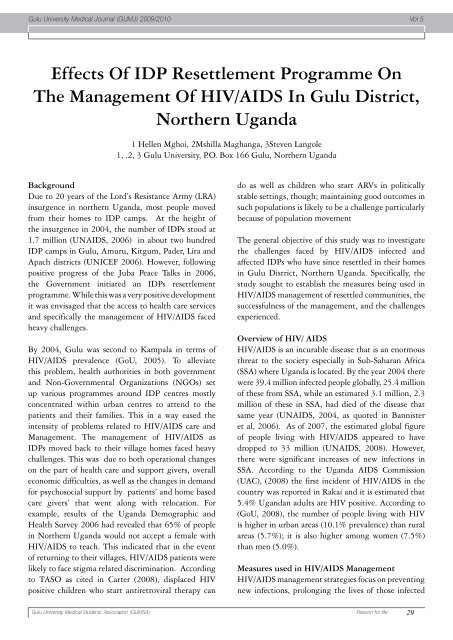GULU UNIVERSITY MEDICAL JOURNAL
GULU UNIVERSITY MEDICAL JOURNAL
GULU UNIVERSITY MEDICAL JOURNAL
You also want an ePaper? Increase the reach of your titles
YUMPU automatically turns print PDFs into web optimized ePapers that Google loves.
Gulu University Medical Journal (GUMJ) 2009/2010 Vol 5.<br />
Effects Of IDP Resettlement Programme On<br />
The Management Of HIV/AIDS In Gulu District,<br />
Northern Uganda<br />
1 Hellen Mghoi, 2Mshilla Maghanga, 3Steven Langole<br />
1, .2, 3 Gulu University, P.O. Box 166 Gulu, Northern Uganda<br />
Background<br />
Due to 20 years of the Lord’s Resistance Army (LRA)<br />
insurgence in northern Uganda, most people moved<br />
from their homes to IDP camps. At the height of<br />
the insurgence in 2004, the number of IDPs stood at<br />
1.7 million (UNAIDS, 2006) in about two hundred<br />
IDP camps in Gulu, Amuru, Kitgum, Pader, Lira and<br />
Apach districts (UNICEF 2006). However, following<br />
positive progress of the Juba Peace Talks in 2006,<br />
the Government initiated an IDPs resettlement<br />
programme. While this was a very positive development<br />
it was envisaged that the access to health care services<br />
and specifically the management of HIV/AIDS faced<br />
heavy challenges.<br />
By 2004, Gulu was second to Kampala in terms of<br />
HIV/AIDS prevalence (GoU, 2005). To alleviate<br />
this problem, health authorities in both government<br />
and Non-Governmental Organizations (NGOs) set<br />
up various programmes around IDP centres mostly<br />
concentrated within urban centres to attend to the<br />
patients and their families. This in a way eased the<br />
intensity of problems related to HIV/AIDS care and<br />
Management. The management of HIV/AIDS as<br />
IDPs moved back to their village homes faced heavy<br />
challenges. This was due to both operational changes<br />
on the part of health care and support givers, overall<br />
economic difficulties, as well as the changes in demand<br />
for psychosocial support by patients’ and home based<br />
care givers’ that went along with relocation. For<br />
example, results of the Uganda Demographic and<br />
Health Survey 2006 had revealed that 65% of people<br />
in Northern Uganda would not accept a female with<br />
HIV/AIDS to teach. This indicated that in the event<br />
of returning to their villages, HIV/AIDS patients were<br />
likely to face stigma related discrimination. According<br />
to TASO as cited in Carter (2008), displaced HIV<br />
positive children who start antiretroviral therapy can<br />
do as well as children who start ARVs in politically<br />
stable settings, though; maintaining good outcomes in<br />
such populations is likely to be a challenge particularly<br />
because of population movement<br />
The general objective of this study was to investigate<br />
the challenges faced by HIV/AIDS infected and<br />
affected IDPs who have since resettled in their homes<br />
in Gulu District, Northern Uganda. Specifically, the<br />
study sought to establish the measures being used in<br />
HIV/AIDS management of resettled communities, the<br />
successfulness of the management, and the challenges<br />
experienced.<br />
Overview of HIV/ AIDS<br />
HIV/AIDS is an incurable disease that is an enormous<br />
threat to the society especially in Sub-Saharan Africa<br />
(SSA) where Uganda is located. By the year 2004 there<br />
were 39.4 million infected people globally, 25.4 million<br />
of these from SSA, while an estimated 3.1 million, 2.3<br />
million of these in SSA, had died of the disease that<br />
same year (UNAIDS, 2004, as quoted in Bannister<br />
et al, 2006). As of 2007, the estimated global figure<br />
of people living with HIV/AIDS appeared to have<br />
dropped to 33 million (UNAIDS, 2008). However,<br />
there were significant increases of new infections in<br />
SSA. According to the Uganda AIDS Commission<br />
(UAC), (2008) the first incident of HIV/AIDS in the<br />
country was reported in Rakai and it is estimated that<br />
5.4% Ugandan adults are HIV positive. According to<br />
(GoU, 2008), the number of people living with HIV<br />
is higher in urban areas (10.1% prevalence) than rural<br />
areas (5.7%); it is also higher among women (7.5%)<br />
than men (5.0%).<br />
Measures used in HIV/AIDS Management<br />
HIV/AIDS management strategies focus on preventing<br />
new infections, prolonging the lives of those infected<br />
Gulu University Medical Students’ Association (GUMSA) Passion for life 29


